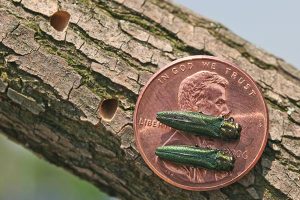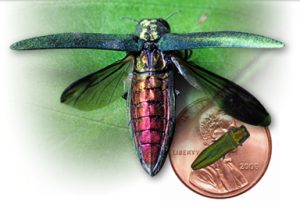 Have you heard of the Emerald Ash Borer? You should if you have ever been to a camp, park or trail location in WI and across the United States and Canada. Emerald Ash Borer (Agrilus planipennis) is an invasive, wood boring beetle. It kills ash trees (Fraxinus spp) by eating the tissues under the bark.
Have you heard of the Emerald Ash Borer? You should if you have ever been to a camp, park or trail location in WI and across the United States and Canada. Emerald Ash Borer (Agrilus planipennis) is an invasive, wood boring beetle. It kills ash trees (Fraxinus spp) by eating the tissues under the bark.
This metallic green beetle is native to East Asia. It was brought to the United States accidentally, in the wood of shipping crates from China. 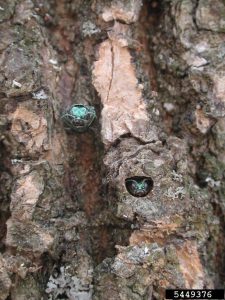
The larva (the immature stage of EAB) spends its life inside ash trees, feeding on the inner bark where we cannot see it. This feeding disrupts the trees’ ability to move water and nutrients back and forth from the roots to the rest of the tree. The tree starves and eventually dies.
A tree that has been attacked by EAB can die within 2-4 years. It is estimated that more than 50 million ash trees are dead or dying in the Midwest because of this insect.
Adult (beetle)
Emerald ash borer adults are very small, metallic green beetles. They are about the size of a cooked grain of rice: only 3/8 – 1/2 inch long and 1/16 inch wide.
Adult emerald ash borers emerge from beneath the bark of ash trees late May through mid-July. They create a D-shaped exit hole as they chew their way out of the tree (pictured on the left). The beetles are most active during warm and sunny days. They never wander far from where they exit a tree (less than one mile) in search of a mate. Once they find a mate, the female will lay 60 – 90 eggs, one at a time, in the crevices of ash tree bark. The beetles will feed lightly on ash tree leaves, but do not cause much harm that way. EAB beetles live a total of three to six weeks.
Larva (immature EAB)
Emerald ash borer larvae are white and slightly flattened, with a pair of brown pincher-like appendages on the last segment. Their size varies as they feed and grow under the ash tree’s bark. Full grown larvae average 1.5 inches in length. They wind back and forth as they feed, creating S-shaped 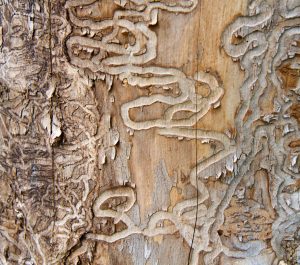 patterns called galleries under the bark (pictured on right). Larvae will feed under the bark for one or two years and can survive in green wood, such as firewood, as long as the bark is attached.
patterns called galleries under the bark (pictured on right). Larvae will feed under the bark for one or two years and can survive in green wood, such as firewood, as long as the bark is attached.
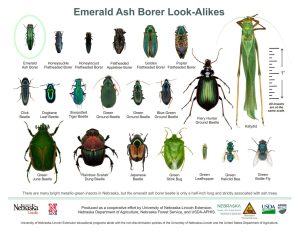 EAB Look-Alikes
EAB Look-Alikes
There are many metallic green insects that are common in Wisconsin and often mistaken for EAB. For more information on these look-alikes please visit the University of Wisconsin – Madison’s emerald ash borer webpage. (Please note that the six-spotted tiger beetle may have any number of spots, or none at all.)
WALWORTH COUNTY IS A QUARANTINE COUNTY!
Prevention
What is Wisconsin doing to prevent EAB?
Although EAB beetles can fly a few miles on their own, they mainly spread to new areas with the help of people. Hitching rides in materials that people move, EAB can spread quickly. Some of the most important steps Wisconsin is taking regarding EAB include:
1. Raising citizen awareness
2. Restricting the movement of firewood and materials that could potentially carry EAB into new locations.
3. Monitoring for evidence of the insect
Wisconsin Rules Helping Prevent EAB Spread
DATCP rule (DATCP 21), allows our state to restrict the movement of certain items coming from areas infested with emerald ash borer (EAB quarantined areas). These items include firewood, logs, mulch or nursery stock.
DNR rule NR 45.04 (1) (g) restricts firewood movement onto DNR managed properties in Wisconsin to prevent the spread of EAB to Wisconsin forests and recreational areas.

